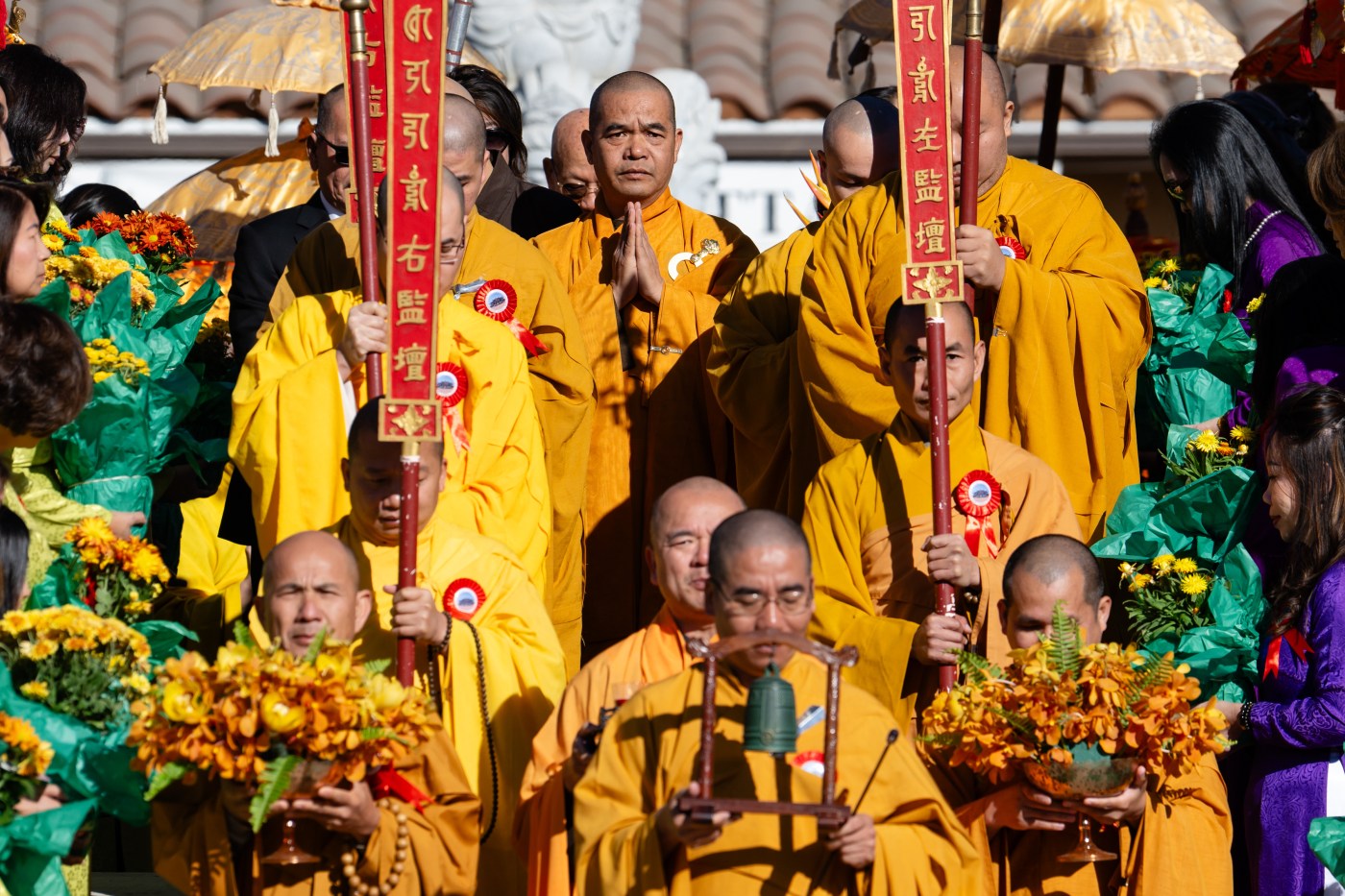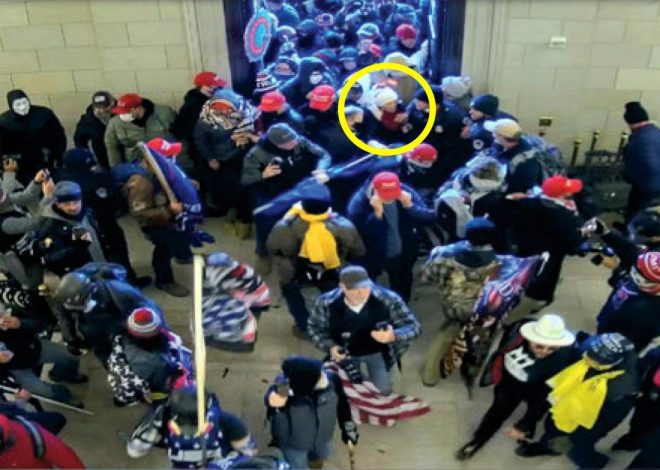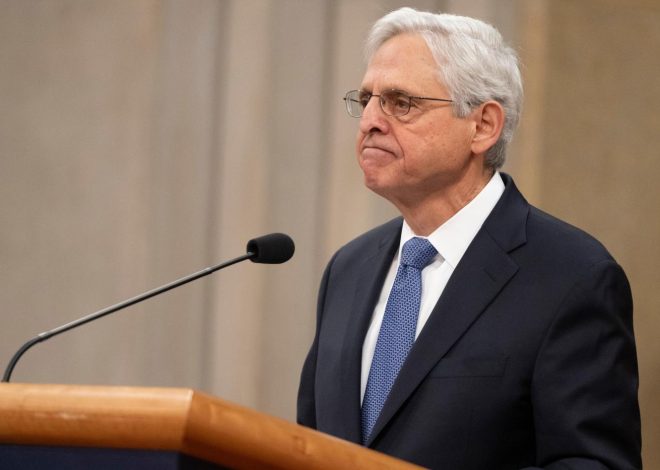
Bay Area’s newest Buddhist temple a sprawling testament to perseverance
Under a cloudless, Kodachrome-blue sky Sunday, nuns and monks with close-shaved heads paraded in saffron and lavender robes, flanked by lines of women in brightly colored dresses carrying orange flowers. The technicolor procession marched forward to the rhythmic chime of a bell, slowly gathering under the flared eaves of the Bay Area’s newest Buddhist temple.
There, the group commemorated the grand opening of the Tâm Từ Metta Vietnamese Buddhist temple – among the largest in the Bay Area — on the southern edge of Morgan Hill. The event, attended by hundreds of monks, nuns, faithful, and supporters from across the globe, also marked the culmination of a decades-long dream to bring a piece of Vietnamese culture to the United States. Now, the temple’s creators hope the temple and surrounding grounds will serve as a refuge not only for the Vietnamese and Buddhist communities, but for those seeking a place for peace and meditation throughout the Bay Area.
“It’s not just a temple to practice Buddhism, it’s a place to remind us of our native country,” said Long Nguyen of San Jose. “There’s never been a place like this before in California.”
While there are several dozen Buddhist communities and some temples scattered throughout the Bay Area, Tâm Từ Metta – whose name translates roughly to “compassion” or “loving-kindness” — stands out in its scope and its homage to styles of architecture from all over Vietnam, according to many in the local Buddhist community. The temple and its surrounding garden sprawl over several acres of land on the southern edge of Morgan Hill, just off of highway 101. Behind the faded bronze fencing, bamboo, palms, and gnarled olive trees grow near pools dotted with lotus. Pillars engraved with Buddhist sutras line stone paths, and granite statues stand watch. Stupas and pagodas offer shade to intricately carved facades.
The entire complex is the brainchild of Thich Phap Chon, a Vietnamese Buddhist monk and the abbot of the temple, who conceived the temple nearly three decades ago.
Chon became a monk when he was only 7 years old in Vietnam. In the shadow of the 1975 overthrow of the Vietnamese government, however, the country enforced stricter rules around religion, suppressing the ability of Buddhists to practice freely. In 1989, he fled his homeland by boat, leaving behind everything he knew.
“I left my temple, my family, and my country,” he recalled, tears welling in his eyes. “I thought to myself, ‘We don’t have a chance to come back to Vietnam, I’ll bring it with me — the temple and the culture.’”
That dream would take some 30 years to realize, however. He bounced across the world to Hong Kong, the Philippines, and later Canada. He finally arrived in the United States in 1996 and, after traveling the country to share Vietnamese culture and Buddhist teachings, settled in San Jose.
In 2000, he founded a Buddhist community, Lieu Quan, in San Jose, but he lacked the land to build a temple. It wasn’t until years later that – on commutes to Gilroy – he saw the wide open spaces surrounding Morgan Hill. In 2009, he purchased a plot of abandoned agricultural land with the help of donations.
“All of it was garbage,” he recalled. The land had piles of trash, debris that rose multiple feet high, and a collapsed greenhouse. Some who had initially supported his vision doubted that he could transform the mess into the temple they had hoped for.
But Chon was determined. “No mud, no lotus,” he said, recalling a teaching by monk Thich Nhat Han that suffering – or in this case, garbage – could be transformed into joy and beauty.
What followed was a 15-year saga, during which he and a group of volunteers set to work restoring the land, turning a barn into a temple building, bringing in trees for the garden, and traveling to China to commission sculptures. They found reclaimed construction materials so that they could cut costs, and Chon even learned how to operate heavy machinery to personally take part in the construction.
The project also required nearly a decade of bureaucratic maneuvering involving Morgan Hill, Santa Clara County, and an obscure regulatory body called LAFCO to get the permission to build the temple on the agricultural land.
The grand opening featured dancing and music, martial arts demonstrations, drumming, chanting and prayer, and was to many a joyous occasion.
“Growing up, temple was my touchstone to Vietnamese culture, Vietnamese food, Vietnamese friends,” said Khoi Le of San Jose. “It’s so special.”
“You know, I feel proud to be here, to see what he brought to America,” said Dieu Hanh, who drove up from San Diego. “Our kids everywhere can go to the temple and learn about Buddhism and learn about Vietnamese culture.”
Along with being a cultural touchstone for the Vietnamese Buddhist community, Chon and his companions hope that the temple and the garden can become a place where Americans might learn more about a culture and a religion beyond their own. They hope those of all stripes can find a place of “peace, tranquility, and refuge,” with the goal being to offer both Buddhist temple and open space for meditation in the coming months.
For Tanya Tran of Saratoga, the complex lends itself to the meditation that is so central to her Buddhist practice.
“It’s a big progress for our community. I’m very proud,” she said.


